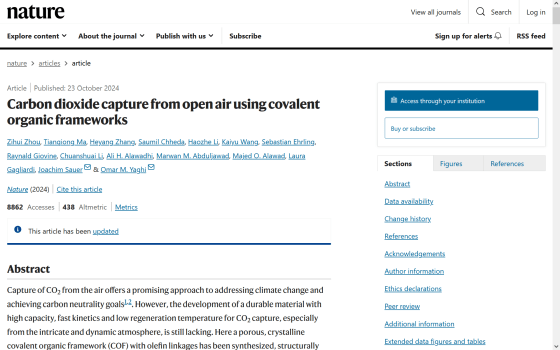A powder has been developed that can absorb as much carbon dioxide as a single tree using just 200g of it

A powder called ' COF-999 ' has been developed that traps greenhouse gases in tiny pores. It is expected to reduce carbon dioxide in the atmosphere and help curb climate change.
Carbon dioxide capture from open air using covalent organic frameworks | Nature

Capturing carbon from the air just got easier - Berkeley News
This powder removes as much CO₂ from the air as a tree - Los Angeles Times
https://www.latimes.com/environment/story/2024-10-23/this-powder-can-remove-as-much-co2-from-the-air-as-a-tree
COF-999, developed by Omar Yaghi and others at the University of California, Berkeley, contains amines that bind to carbon dioxide and efficiently absorb carbon dioxide from the air.
When viewed under a scanning electron microscope, COF-999 looks like a tiny basketball with billions of holes in it, and the porous design increases its surface area, allowing it to capture carbon dioxide at a rate that is 'at least 10 times faster' than other materials.

COF-999 has the ability to absorb 0.96 mmol of carbon dioxide per gram under dry conditions and 2.05 mmol per gram at 50% humidity, and its absorption efficiency improves particularly as the humidity increases.
In an experiment in which the powder was packed into a stainless steel tube the size of a straw and left outside, it was found to have completely removed carbon dioxide from air containing 410 to 517 ppm of carbon dioxide.
It is said that a typical large tree can absorb as much as 40 kg of carbon dioxide from the air in a year, but COF-999 can absorb the same amount of carbon dioxide with just about 200 g.

In addition to its high absorption capacity, another feature of this material is that it can release the carbon dioxide it has absorbed when heated to about 60°C. Other similar materials require heating to 120°C, so the fact that it can be processed at low temperatures is a major advantage.
This could allow the structure to absorb carbon dioxide, release it underground where it is less affected, and then absorb carbon dioxide again above ground. In experiments, the structure maintained a stable structure even after 100 cycles of absorption and release, and Yaghi said, 'It's fine for several thousand cycles.'
'Even if we stop emitting carbon dioxide, we still need to take it out of the atmosphere. There is no other option,' said Yagi. He expressed his enthusiasm for developing and deploying COF-999 as a way to remove carbon dioxide from the atmosphere.
Related Posts:
in Science, Posted by log1p_kr







